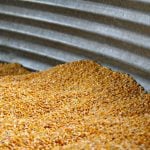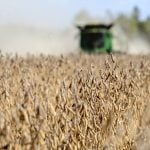The January cattle on feed report for Alberta-Saskatchewan showed inventories at 929,725 head, eight percent more than last year at this time. This number is in line with the five year average, but this is the fourth smallest January inventory since reporting began in 2000.
However, December placements were the smallest since reporting began with 111,544 put on feed, but it was 12 percent better than 2016.
Heifer placements in December were strong, particularly among those in the more than 800 pound category. Heifers as a percent of total placements were 48 percent for December, compared to the five year average of slightly less 40 percent.
Read Also

Chinese offer complicates canola marketing
Recently the Chinese ambassador indicated that there would be a potential deal between Canada and China regarding the current tariff war.
Alberta feeders lower
Alberta feeder prices were lower across the board this week by $5 per hundredweight for steers and $3.50 per cwt. for heifers because of softer outside buying interest and limited feeding profitability.
Lethbridge barley for January to March-March delivery has traded around $220 per tonne and has added to those shrinking feeding margins.
Alberta fed prices up
Alberta fed prices continue to hold a sizable premium to both the Ontario and Nebraska markets, trading $4 per cwt. higher than last year, while Ontario prices are $7 per cwt. lower. The western Canadian fed market has spent the last three weeks averaging in the mid $160s per cwt.
Early placed yearlings are making money for feedlots, where profits are ranging from $50 to 175 per head.
Strong basis
Cash to futures basis levels have averaged +15.93 for the first three weeks in January, and cash to cash basis levels have averaged around +13.50, the strongest levels ever seen in January.
Slaughter volumes up
Canadian weekly fed slaughter volumes totalled 46,245 head, up 28 percent for the same week last year.
This has resulted in more than 40 million pounds of beef, the largest weekly production volume since January 2011.
However, reduced slaughter rates at all three western Canadian plants were reported because of maintenance issues or hour reductions.
Cow prices down
Slaughter cow prices slipped $1 per cwt. with dressed bids down $2 per cwt. Bids were reported at $181-$186 per cwt. delivered. With ample supplies, prices are expected to trend lower next week.
Alberta prices continue to be at a significant premium to U.S. cull cow prices.
Western Canadian non-fed slaughter for the week ending Jan. 13 was 25 percent larger than the week previous at slightly more than 9,000 head.
Exports of cows and bulls to the United States are generally trending downward.
Cattle slaughter up
Total Canadian cattle slaughter in 2017 at federally and provincially inspected plants reached nearly three million head, up seven percent from 2016 and eight percent over the five year average.
This was the largest annual slaughter since 2011.
Federally inspected slaughter capacity expanded to 66,600 head per week with the opening of Harmony Beef in Alberta. Utilization levels improved from an average of 80 percent in 2016 to 82 percent in 2017.
Utilization rates are expected to improve even more in 2018.
Western slaughter reached 2.25 million head, up seven percent from 2016 and 10 percent more than the five year average. This represents 75 percent of the Canadian kill.
Steer slaughter remains relatively stable, but there is wide variation among heifers, cows and bulls. Heifer slaughter went up 11 percent, cows were up 14 percent and the bull kill increased by 15 percent, all higher than the five year average.
Cow marketings are expected to go up, but exports from this category are going down.














